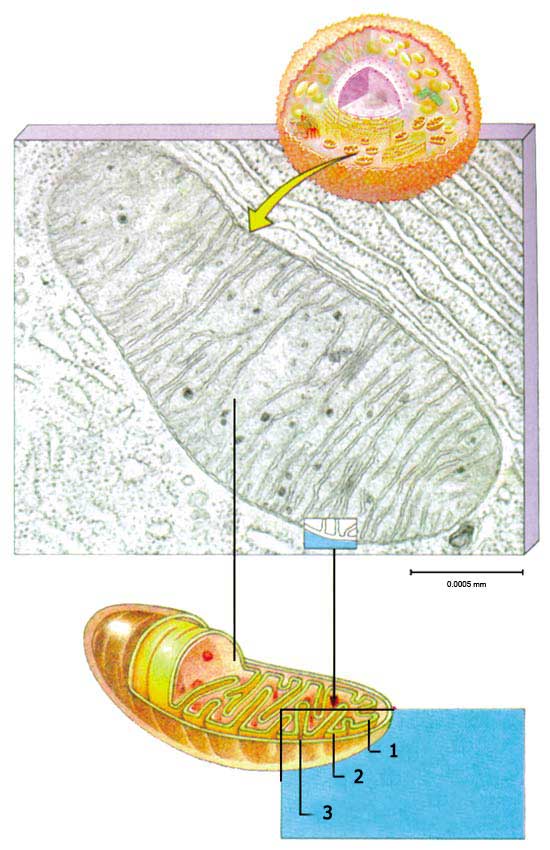 |
1. Inner membrane Figure 8.1 A micrograph and cross section of the cell's power station, the mitochondria |
The crucial need for energy that we cannot do without is a key factor in many vital areas such as technology and industry, transport and communication. This is why massive dams, refineries, and even nuclear power plants are built, and why a large proportion of a country's budget is allocated to energy production. We spend a lot of money even on the cars we use for everyday business.
So if energy is so expensive, how does the body produce the energy it uses? Where does it get its energy from, and in what form is it used?
In order to produce the energy it needs, the body utilizes hundreds of tiny power stations called mitochondria (See Figure 8.1). There, the chemical energy obtained from nutrients in your diet is packaged in packets called ATP that your cells can use. All processes in the cell that promote life take place as a result of the energy readily available in these energy packets produced in the mitochondria.
So what is the cost of this energy?
For comparison's sake, consider the gasoline that fuels your car. This is first drilled out of the ground in the form of crude oil, then transported by ship to refineries, where it passes through many complex chemical processes that convert it into gasoline. The motor in your car and the gas it uses are both made to work with each other. Your car will not run on any other fuel. In a similar way, the electricity is produced with great effort and expense in hydroelectric dams and huge hydroelectric power stations. In both cases, advanced knowledge and technology are utilized.
Present in the cell is a much more perfect system than those mentioned above. The primary source of all energy is the Sun. Plants use sunlight to make food or, more correctly, they use the energy in sunlight and store it in the form of nutrients they produce. The human body breaks down into smaller parts the nutrients it receives from these plants, and from animals that feed on these plants. These small molecules, which make up the raw materials of energy production are oxidized by the cell and taken to the mitochondria, the cell's power station. The mitochondria breaks these down even further, releasing the energy contained within, and converts this energy into ATP, a form of energy the cell can use. All the events taking place in the cell occur as a result of the energy this fuel provides. Up till now, what we have given is a very short summary of the highly complex chemical reactions that actually take place during the production of energy in the mitochondria. These chemical miracles occur in an area only 100th of a millimeter-an area too small to even conceive of.
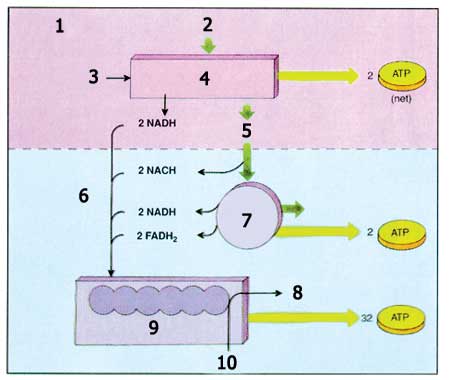 | 1. Cytoplasm | 7. Krebs Cycle |
Figure 8.2 | ||
In the cell, oxygen plays the major role in the production of energy. During each stage, many different enzymes go into action. Enzymes that finish their duty at one stage give way to other enzymes for the next. These dozens of minor processes, hundreds of different enzyme transformations, and endless chemical reactions lead to the conversion of the energy stored in food into a form the cell can use (See Figures 8.2, 8.3, and 8.4).
Thus we can state that the cell's power station is much more complex than a gasoline refinery or hydroelectric station.
An oil refinery is built by engineers who know the technical information and chemical analyses of crude oil in laboratories. It's difficult to imagine people who know nothing about petroleum building a refinery. But this impossibility is no problem when it comes to mitochondria's energy production in the cell. Because a fertilized egg develops in the mother's womb and divides to form a human baby, the mitochondria in its cells have never had contact with the outside world, nor-until birth-have they ever encountered a single nutrient. But despite this, they still know how to harvest the energy inside foods, and they carry this complex process out without fault.
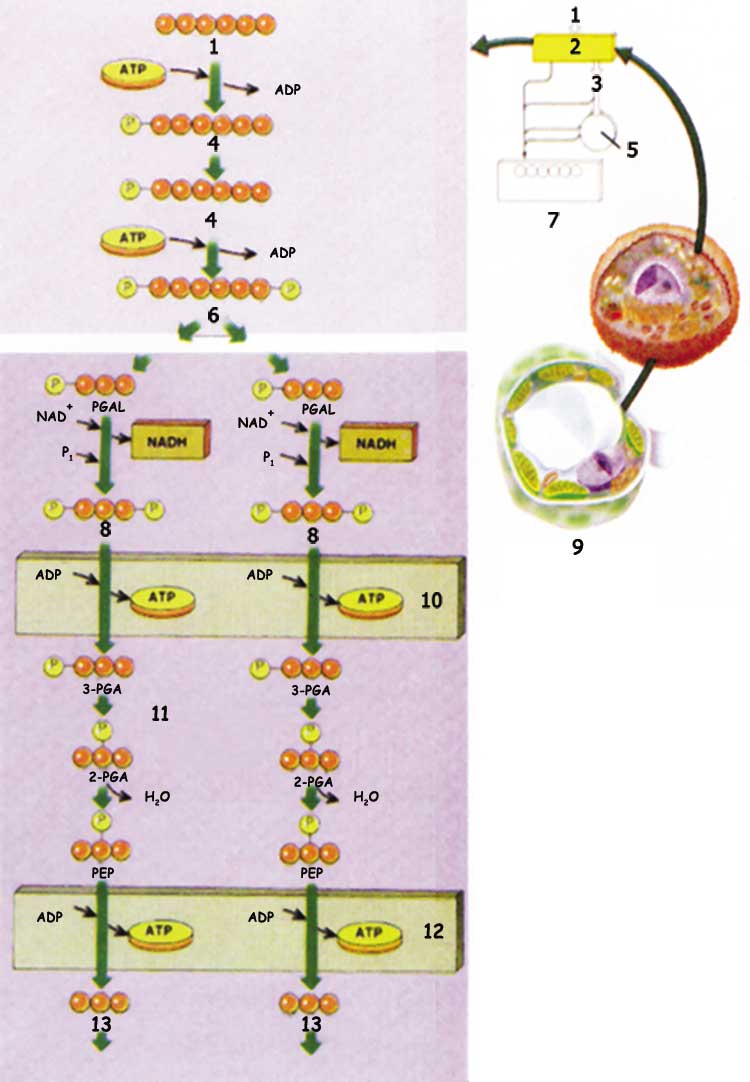 | |
1. Glucose | 8. 1,3-biphosphoglyceric acid |
Figure 8.3 This first step leads to the formation of two molecules of PGAL (phosphoglyceraldehyde), which indicates the start of energy production. Enzymes transfer the protons and electrons they obtain from PGAL to NAD+ to produce two molecules of NADH. After receiving protons and electrons, NAD+ becomes activated and then returns these to its surroundings, thereby forming NADH+. Later on, each substrate group gives a phosphate group to ADP, to form two ATPs. The same processes are carried out for four ATPs. For every four ATPs produced, two ATPs are used at the start of glycolysis, resulting in a net two ATPs being produced. | |
Where did the mitochondria learn such a skill?
The truth is that no organelle can "learn" a biological function, in the dictionary meaning of the word. If it did not possess the features to carry out any such function during the formation of the cell, there would be no way for it to obtain them later. A precondition for such a system is its complete existence right from the start. Otherwise, the oxygen that plays such a major role in energy production will, at that point, destroy the cell. The cell must have been equipped with a perfect system of withstanding oxygen, right from when it first formed. It must have been able to take up O2 gas, which has the ability to destroy it, and use it to produce the important energy it needs to continue its life.
The mitochondrion's purpose is to produce energy using oxygen. And as mentioned above, it can't do this without a series of enzymes working back to back. These enzymes can be passed onto the next generation through a hereditary, via the information stored in the DNA, but no living organism can learn this structural organization on its own. This system is so developed and detailed that even intelligent humans, with all their capabilities, cannot create such a system.
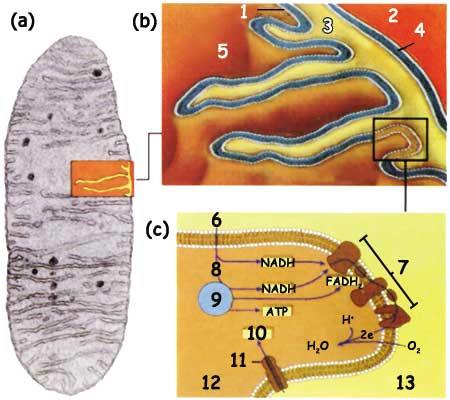 | 1. Inner membrane |
Figures 8.4 and Figure 8.5 The functional compartments of the mitochondrion a) Mitochondrion from the pancreatic cell of a bat b) The membrane in the inner compartment of the mitochondrion divides up the organelle into two regions. | |
c) The inner region is where the second stage of aerobic respiration (including the Krebs cycle) takes place. NAD and FAD are converted into NADH and FADH2 by reacting with H+ and electrons. These are sent to the transport system in the inner membrane. The concentration of H+ ions and electric charge changes as a result of the processes that take place in the third stage. As a result of these changes and the effect of the ATP enzyme (ATP synthetase), ATP is produced. | |
Consequently, evolutionist scientists are forced to accept that the mitochondrion's extraordinary system must have formed in one instant. The following admission of Prof. Ali Demirsoy, a well-known Turkish evolutionist, is highly enlightening:
The heart of the problem is how the mitochondria have acquired this feature (that is, of using oxygen to produce energy), because attaining this feature by chance even by one individual, requires extreme probabilities that are incomprehensible... The enzymes providing respiration and functioning as a catalyst in each step in a different form make up the core of the mechanism. A cell has to contain this enzyme sequence completely, otherwise it is meaningless. Here, despite being contrary to biological thought, in order to avoid a more dogmatic explanation or speculation, we have to accept, though reluctantly, that all the respiration enzymes completely existed in the cell before the cell first came in contact with oxygen.14
 | ||
A. Preparatory Conversions 1. Pyruvic acid
| 3. Acetyl CoA | 8. Fumarate |
Figure 8.6 As the diagram shows, before entering the Krebs cycle, the pyruvate is completely converted into acetyl coenzyme A, which then enters the Krebs cycle and combines with oxaloacetate (The Krebs cycle got its name from the scientist who worked on it in the 1930s). The Krebs cycle has three functions: The first is to obtain H+ and electrons to transfer to coenzymes such as NAD and FAD. The second is production of ATP by phosphorylation. And the third is to convert the many different substances in the center of the cycle, obtained after many steps by many different enzymes, back into oxaloacetate. If this reconversion was not done, and there is only a limited amount of oxaloacetate in the cell, respiration would soon stop. But because of the extraordinary measures taken by God, oxaloacetate is always regenerated. The incredible reactions that take place in the second step produce only two ATPs. But many of the coenzymes, H+ ions and electrons produced in this step are used in the third and final stage of respiration. | ||
This extract is one example of the damage inflicted on evolutionary logic. Despite all these facts and even though evolutionists refuse to admit it, this situation has only one explanation: Mitochondria were created by a Possessor of intelligence that knows the human body and the vegetable kingdom in the greatest detail. In other words, the power that created the mitochondria is God, "Who encompasses all things in His knowledge" (Qur'an, 6:80). Another verse stresses the same truth in the following manner: "What! Does He not encompass all things?" (Qur'an, 41:54)
 | 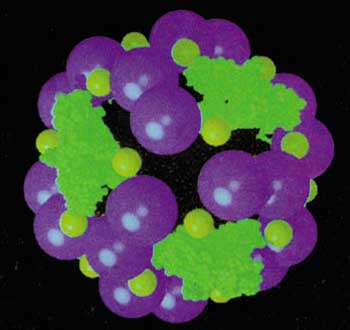 |
Figure 8.7 | |
14-Ali Demirsoy, Kalitim ve Evrim (Inheritance and Evolution) (Ankara: Meteksan Publishing Co., 1984), p. 94.